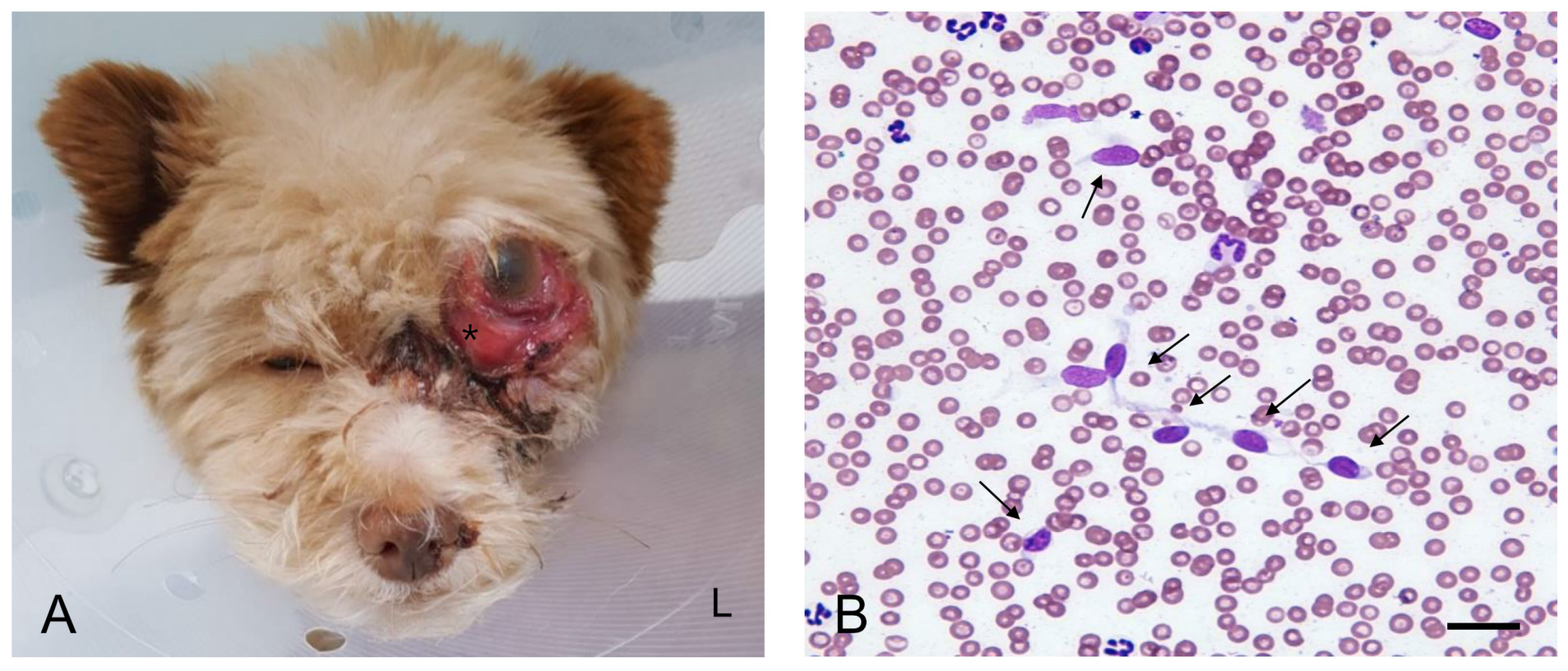Mesenchymal neoplasm dogs
Mesenchymal Neoplasm Dogs. Neoplastic cells may be benign or malignant and require evaluation and testing for a definitive diagnosis. Mesenchymal tumors are rare 11 in dogs but are aggressive and highly metastatic. Fibrosarcoma Tumors in Dogs. Tumors tend to form on the dog gums with symptoms such as a bad odor dog nose bleeding dog gum bleeding or refusal to eat.
 Photomicrographs Of Cutaneous And Mesenchymal Tumors Of Canine A Download Scientific Diagram From researchgate.net
Photomicrographs Of Cutaneous And Mesenchymal Tumors Of Canine A Download Scientific Diagram From researchgate.net
Tumors tend to form on the dog gums with symptoms such as a bad odor dog nose bleeding dog gum bleeding or refusal to eat. The dog mouth cancer spreads quickly so early treatment is essential. 5 The relative incidence of focal versus multiorgan MFH in dogs is difficult to determine because most diagnoses are made on. Three forms of fibrosarcoma have been described in. Nephroblastoma is a congenital renal tumor with both epithelial and mesenchymal components. Melanomas which are pigmented tumors.
The average age of the dogs with ordinary chondrosarcoma was 87 years and the male to female ratio was 4.
Mesenchymal Proliferation in Dogs. Lipomas fibrosarcomas and hemangiosarcomas. Anatomic classification immunohistochemistry and mitotic activity correlated with patient survival Vet Pathol. Four examples ofa mesenchymal tumor of undetermined histogenesis occurred in three mixed breed dogs and one Yorkshire terrier. Dog mouth cancer or neoplasia is common. Mesenchymal renal tumors include HSA FSA CSA and leiomyosarcoma.
 Source: msdvetmanual.com
Source: msdvetmanual.com
So a mesenchymal neoplasm is a growthtumor composed of the undifferentiated cells that make up the mesenchyme. Despite dose intensification with conventional cytotoxic therapies survival times for dogs and humans diagnosed. Mesenchymal tissue neoplasms are soft tissue tumors also known as connective tissue tumors which are relatively frequent in domestic animals and have a high incidence in some species. About a third of all tumors that occur in canines are mesenchymal. Connective tissue includes fibrous adipose bone cartilage and muscle connective tissue.
 Source: todaysveterinarypractice.com
Source: todaysveterinarypractice.com
Some are quite benign and others can be quite serious. Usually though mast cell tumors are fairly obvious on cytology. When I checked last night the sources I looked at named three types of mesenchymal neoplasias. However oftentimes tumors that may have the potential to become malignant are passed over as benign lesions. Since the metastatic neoplasia are cancer cells that travelled from a tumor somewhere in your dogs body the symptoms will be mostly related to the primary tumor area.
 Source: researchgate.net
Source: researchgate.net
Lipomas fibrosarcomas and hemangiosarcomas. Mesenchymal tumors are rare 11 in dogs but are aggressive and highly metastatic. However oftentimes tumors that may have the potential to become malignant are passed over as benign lesions. Fibrosarcoma cat Fibrosarcoma cat Keloidal fibromafibrosarcoma DQ Keloidal fibromafibrosarcoma DQ Keloidal fibromafibrosarcoma DQ Keloidal fibromafibrosarcoma PB Giant cell tumor of soft parts horse. The fact that the cytologist didnt suggest a mast cell tumor makes this less likely.
 Source: todaysveterinarypractice.com
Source: todaysveterinarypractice.com
Despite dose intensification with conventional cytotoxic therapies survival times for dogs and humans diagnosed. This malignant mesenchymal tumor is well described in dogs and cats andcats and is the most common tumor in domestic felines 7 1112. Primary mesenchymal nonangiomatousnonlymphomatous neoplasms occurring in the canine spleen. Three forms of fibrosarcoma have been described in. The dogs with mesenchymal chondrosarcoma was 68 years.
 Source: veteriankey.com
Source: veteriankey.com
Neurofibromas peripheral nerve sheath tumors spindle cell tumors schwannomas and hemangiopericytomas are all names for fibrosarcoma-type tumors. It arises in the skin as a single expansive tumor or it may appear as part of a multiorgan disease that often involves lungs lymph nodes spleen liver bones and kidneys. Fibrosarcoma Tumors in Dogs. Mesenchymal renal tumors include HSA FSA CSA and leiomyosarcoma. Because of its lack of polarity mesenchymal tissue can form tumors and spread rapidly.
 Source: todaysveterinarypractice.com
Source: todaysveterinarypractice.com
Three forms of fibrosarcoma have been described in. Mesenchymal tissue neoplasms are soft tissue tumors also known as connective tissue tumors which are relatively frequent in domestic animals and have a high incidence in some species. These tumors may be located in all organs with a higher. However oftentimes tumors that may have the potential to become malignant are passed over as benign lesions. 5 Golden retrievers and rottweilers are overrepresented for MFH.
 Source: msdvetmanual.com
Source: msdvetmanual.com
Fibrosarcoma Tumors in Dogs. Round cell tumors which can be of several types including lymphosarcoma mast cell tumors histiocytomas plasma cell tumors. Primary mesenchymal nonangiomatousnonlymphomatous neoplasms occurring in the canine spleen. Mesenchymal Proliferation in Dogs. However the areas where the neoplasia ends up will also send out signs of problems.
 Source: mdpi.com
Source: mdpi.com
All tumors occurred as solitary soft to firm solid tan and ulcerated masses in the digits ofdogs aged II to 15 years. Neoplasia in dogs refers to the abnormal and uncontrolled growth of cells in any part of the body. Mesenchymal renal tumors include HSA FSA CSA and leiomyosarcoma. Mesenchymal tumors appear on the skin and are the most common type of tumors in dogs. The dog mouth cancer spreads quickly so early treatment is essential.
 Source: researchgate.net
Source: researchgate.net
The mesenchymal chondrosarcomas were composed. Tumors tend to form on the dog gums with symptoms such as a bad odor dog nose bleeding dog gum bleeding or refusal to eat. Mesenchymal tissue is made up of loosely associated cells which means this type of tissue can migrate easily. The mesenchymal chondrosarcomas were composed. A mesenchymal neoplasm generally involves abnormal cellular growth in bone connective tissue or the lymph and circulatory systems.
 Source: researchgate.net
Source: researchgate.net
Dogs with mesenchymal tumours had two times higher odds of potential for malignancy than those with epithelial tumours. Since the metastatic neoplasia are cancer cells that travelled from a tumor somewhere in your dogs body the symptoms will be mostly related to the primary tumor area. All tumors occurred as solitary soft to firm solid tan and ulcerated masses in the digits ofdogs aged II to 15 years. Neoplastic cells may be benign or malignant and require evaluation and testing for a definitive diagnosis. These tumors may be located in all organs with a higher.
 Source: researchgate.net
Source: researchgate.net
5 Golden retrievers and rottweilers are overrepresented for MFH. Fibrosarcoma cat Fibrosarcoma cat Keloidal fibromafibrosarcoma DQ Keloidal fibromafibrosarcoma DQ Keloidal fibromafibrosarcoma DQ Keloidal fibromafibrosarcoma PB Giant cell tumor of soft parts horse. Melanomas which are pigmented tumors. About a third of all tumors that occur in canines are mesenchymal. The male to female ratio was 23.
 Source: cancerres.aacrjournals.org
Source: cancerres.aacrjournals.org
685 1319 were younger than eight years. The male to female ratio was 23. Round cell tumors which can be of several types including lymphosarcoma mast cell tumors histiocytomas plasma cell tumors. Most pose no threat to the dog. Neoplasia in dogs refers to the abnormal and uncontrolled growth of cells in any part of the body.
If you find this site helpful, please support us by sharing this posts to your preference social media accounts like Facebook, Instagram and so on or you can also save this blog page with the title mesenchymal neoplasm dogs by using Ctrl + D for devices a laptop with a Windows operating system or Command + D for laptops with an Apple operating system. If you use a smartphone, you can also use the drawer menu of the browser you are using. Whether it’s a Windows, Mac, iOS or Android operating system, you will still be able to bookmark this website.







